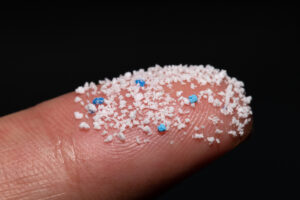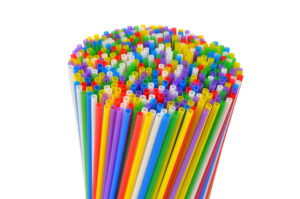Epic epochs
Remember studying the different “epochs,” those periods of time in history typically marked by notable events or particular characteristics? We had the Stone Age, the Bronze Age, the Iron Age. That’s how we learned about the development of different civilizations and cultures. The study focused on the ways humans used the environment to develop tools and resources to support population growth and control their destiny.
Welcome to the Anthropocene
The Anthropocene Epoch was first introduced by Paul Crutzen (1955 Nobel Prize in Chemistry) to describe the period in time during which human actions have had a drastic effect on the Earth and its ecosystems. This includes anthropogenic climate change (relating to, or resulting from the influence of human beings on nature) and its impact on the Earth. The Anthropocene also has become known as the plastic age, defined by plastic pollution everywhere.
Experts suggest this new epoch originated around the 1950s and defines by some of the following:
- Radioactive elements dispersed across the planet
- Overwhelming and consistent plastic pollution
- Nuclear bomb testing and leaks from nuclear power plants
- Soot from coal-powered power plants
- Bones left by the global proliferation of domesticated chickens.
Evidence now appears undeniable that the Earth has been so profoundly changed (by humans) that the Holocene Epoch (current geological epoch that started about 12,000 years ago, after the last glacial period) is giving way to the Anthropocene Epoch.
Microplastics
The term “microplastics” was introduced in 2004 by Professor Richard Thompson, a marine biologist from the United Kingdom. Two classifications of microplastics currently exist.
- Primary microplastics are any plastic fragments or particles that are 5.0-mm in size or less before entering the environment. These include microfibers from clothing, microbeads, and plastic pellets (also known as nurdles).
- Secondary microplastics are created from degradation of larger plastic products once they enter the environment through natural weathering processes. Such sources of secondary microplastics include bottles (water and soda), fishing nets, and plastic bags.
Both types are recognized to persist in the environment at high levels, particularly in aquatic and marine ecosystems.
Sources of microplastics
Microplastic can be found virtually everywhere in our environment.
- Wastewater treatment plants remove contaminants from household sewage. The process requires physical, chemical, and biological processes.
- Wear and tear from car and truck tires leaves microplastic on the road.
- Cosmetic companies have replaced natural exfoliates with microplastics, usually in the form of “microbeads” or “micro-exfoliates” composed of polyethylene. Microplastics are also found in face washes, hand soaps, and other personal care products.
- Many synthetic fibers, such as polyester, nylon, acrylics, and spandex are composed of plastic derivatives. Each laundry load can shed more than 1,900 fibers of microplastics (Fleeces release the highest percentage.)
- Manufacturers of plastic products use granules and small resin pellets as raw material. Through accidental spillage during land or sea transport, inappropriate use as packing materials, and direct outflow from processing plants, these raw materials enter aquatic ecosystems. Fish often consume them.
- The commercial and recreational fishing industry are sources of plastic that directly enter the aquatic environment.
- In one study, 93 percent of bottled water from 11 different brands showed microplastic contamination. Per liter, researchers found an average of 325 microplastic particles. Compared to water from taps, water from plastic bottles contained twice the amount of microplastics.
Microplastics and humans
Plastics are nearly impossible to avoid for anyone living in the U.S. Plastic lines soup cans, leaches out of storage containers, hides in household dust, and is found inside toys, electronics, shampoos, cosmetics, and countless other products. It’s used to make thousands of single-use items, from grocery bags to forks to candy wrappers to the much-maligned plastic straw.
Because research into microplastics and health outcomes is so new, there’s not yet enough data to say exactly how they’re affecting long-term human health. However, research suggests chemicals found in different plastics link, casually or causally, to several health problems, including reproductive disorders and obesity, plus hormonal problems and developmental delays in children.
How much plastic do you ingest?
We take in plastic particles through any number of activities. We swallow them through drinking water and eating fish that contain microplastics. We absorb them through the skin via cosmetics or lotions. And we inhale them in the air particles we breathe.
One research review calculated that just by eating, drinking, and breathing, the average American ingests at least 50,000 microplastic particles every year. Other estimates suggest a far higher value. One study found the average person consumes about 5 grams of plastic a week — the rough equivalent of a credit card.
Microplastics and health
Some researchers hypothesize that chemicals used to make plastics act as a vector for pathogens, as well as heavy metals. Evidence from several animal studies and some human research suggests these microplastics can cross directly into the bloodstream — that means mothers can pass microplastics through the placenta to a developing fetus. And once these chemicals enter the body, even in low doses, they can have detrimental health effects.
For example, bisphenols, a group of chemicals used to manufacture plastics, epoxy resins, and other products, are known to interfere with human hormones. These studies link bisphenol exposure to reduced fertility in men and women. Phthalates, a group of chemicals used in hundreds of products such as toys, vinyl floor- and wall coverings, detergents, lubricating oils, food packaging, pharmaceuticals, tubing, and personal care products are known to disrupt hormonal function.Also, prenatal exposure to phthalates links to lower testosterone in male offspring. Still another chemical, styrene, found in plastic and some food packaging links to several health issues, including nervous system problems, hearing loss, and cancer. BPA (bisphenol A), an industrial chemical used to make certain plastics and resins to harden plastic, are thought to cause a wide range of disorders including cardiovascular disease, type 2 diabetes, and abnormal liver function.
The flame retardant Tetrabromobisphenol A (TBBPA), used in many different types of plastics found in microcircuits, links to disruptions in thyroid hormones, pituitary function, and infertility in lab rats.
In 2018, the American Academy of Pediatrics (AAP) released a report saying chemicals, including bisphenols and phthalates, may put children’s health at risk. The researchers recommended families reduce exposure to these chemicals.
Reducing your exposure to plastic
Here are a few suggestions to reduce your ingestion of microplastics.
-
Avoid foods and drinks packaged in plastic. Since drinking water represents one of the biggest contributors to microplastic ingestion, opt for drinking tap water instead of anything in a plastic bottle, unless you know your tap water is unsafe. (There are many ways to filter tap water if you are unsure.)
- Warm your food in the oven or on the stove, or in a glass container in a microwave, instead of plastic containers. Heated plastic can leach chemicals into food. The American Academy of Pediatrics also recommends not putting plastics into a dishwasher.
- The recycling codes “3,” “6,” and “7,” usually found in the recycling symbol on the bottom of any plastic container, indicate the presence of either phthalates, styrene, or bisphenols — so avoid using these containers. Products labeled as “biobased” or “greenware” do not contain bisphenols.
- While levels of microplastics in organic fresh produce have been largely untested to date, they are less likely to contain unwanted chemicals, compared with anything wrapped in plastic.
- Household dust can contain phthalates, PFAS (Per– and Polyfluoroalkyl chemicals used as an industrial surfactant), and flame retardants. Thus, vacuuming regularly can help reduce exposure. It’s possible that air purifiers may help, but little research exists regarding their effectiveness.
A major health crisis?
Industry estimates show plastic production is expected to quadruple by 2050. This represents a major health crisis. Each of us can limit our plastic exposure by opting for products packaged in glass instead of plastic, using reusable non-plastic containers whenever possible, and support regulations and policies limiting the use of single-use plastic, including polystyrene foam cups and containers, plastic bags, and straws.
The momentum for state and federal action on single-use plastics is taking off. In 2019, Maine, Maryland, and Vermont become the first states to ban plastic foam containers. Connecticut, Delaware, Maine, New York, Oregon, and Vermont joined California in banning single-use plastic grocery bags – tripling the number of single-use-bag bans in just two months. And California and Vermont passed statewide bills requiring plastic straws be given only upon request at restaurants. Also, at least 10 cities/counties in the U.S. have ordinances that ban and or place fees on plastic-bag use
Sadly, Michigan has yet to pass regulations on plastic-bag use. In 2016, lawmakers actually passed legislation banning local communities from banning plastic bags and other single-use containers. But just recently, House Bill 4500 was introduced to repeal the 2016 law. So far, there has been no legislative action. So, initially there was a push to ban, and then a state law to ban banning, and now the legislators want to ban the banning of banning.
I’m not kidding, you can’t make this stuff up. Do you have any questions or suggestions about avoiding microplastics? Please share in the comments section below!
References
- Christensen, J. 2019. “It is raining plastic: Scientists find colorful microplastic in rain.” CNN.
- Cooper, A.H., et al. 2018. “Humans are the most significant global geomorphological driving force of the 21st Century.” Anthropocene Review;1.
- Geyer, R., et al. 2017. “Production, use, and fate of all plastics ever made.” Science Advances; 3(7),e1700782.
- Leahy, S. 2019. “Microplastics are raining down from the sky.” National Geographic.
- Summerhayes, C. and Zalsiewicz, J. 2018. “Global warming and the Anthropocene.” Geology Today; 34(5):194.







Douglas Kelbaugh - 1968, 1972 (Princeton)
Victor et al.,
It turns out that plastics, especially micro-plastics, are an even more complex challenge than your excellent article describes. There’s a ways to go before we understand all the issues, as outlined in this recent article:
https://www.scientificamerican.com/article/wait-plastic-can-be-good-for-the-environment/
It’s clearly a pervasive and epic problem.
Thanks for starting the dialogue,
Doug Kelbaugh, Professor of Architecture and Urban Planning
Reply
Katie Davis - 2004
Hi Victor –
I don’t want to be ingesting plastic that my body doesn’t know how to digest…especially since it seems to be getting worse and not any better.
Do you have any recommendations for a water filter that removes microplastics so I can protect my family? The berkey in the article below says they do, but would like your opinion on this water filter and/or others on the market.
https://www.bigberkeywaterfilters.com/blog/microplastics/can-berkey-remove-microplastics-from-water/
BTW, Thank you for writing this!
Reply